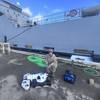SPECIAL REPORT: GREAT LAKES BUSINESS and The Great Lakes Group
Embracing and spanning the full breadth of Great Lakes geography and business mix, GLG’s Joe Starck has his multi-missioned firm looking to the future – in more ways than one.
The Great Lakes Group (GLG) takes its beginnings from its 1899 incorporation by industrial icon John D. Rockefeller, who formed the Great Lakes Towing to satisfy the demands of a Midwest industrial revolution that brought bigger ships to the region. Existing vessels, unable to keep up with demand, were supplemented and replaced by a fleet of as many as 100 tugboats; the first steel tugs in the region. GLG still has a tug that was part of that original operation. Built in 1897; it remains in service today.
Today, GLG is a full-service marine transportation organization made up of diversified marine-related companies, all operating on the Great Lakes. Its fleet of vessels has an eye-popping average age of about 100 years, all of them built between 1900 and the early 1930’s. GLG President Joseph P. Starck told MarineNews in late May, “They were re-powered in the late 1940’s and 1950’s with diesel. All were built with steam, converted to diesel, and some of them have been re-powered multiple times.” That’s not to say that GLG is sitting on its hands. They are not.
“The tug that was built in 1897 has been repowered five times and sank twice. You just can’t keep doing that and keep up with the times,” explained Starck, continuing, “And Subchapter M has really pushed us over the edge, at this point, in maintenance and repair. That isn’t affordable anymore and that’s why we’re building new tugs.”
- The GLG Portfolio
Great Lakes Towing was the original company, and from Great Lakes Towing several other companies were born. Tugs International was formed in the mid-1990s to build new tugs – it was formed to build tractor tugs. Kept separate from Great Lakes Towing, it was primarily a non-operating company, intended to own and charter vessels to others. Today, theirs is only one of those boats left that GLG still owns and it is on charter to Moran.
Soo Line Handling – still another GLG company – operates out of Sault Ste. Marie, Michigan. This firm handles lines for foreign-flag ships at the locks. GLG more or less ties that mission into its harbor towing operation there. Back in Ohio, Great Lakes Shipyard, an operating division of Great Lakes Towing, has always been the towing company’s yard in Cleveland. “The original fleet was built here, and from the 1960’s through the mid-2000s, we were primarily a repair operation,” says Starck. Eventually, the yard got back into new construction again. Back in 2006, Starck says that GLG essentially leveled the yard and put up all the new facilities.
Today, the Great Lakes towing company – the largest U.S.-flagged tugboat fleet operating on the Great Lakes – consists of 30 vessels, operating in 11 ports between Duluth and Buffalo. The vast majority of that work consists of ship assist work, what Starck characterizes as “the primary mission of the company.” Along the way, however, GLG does a little icebreaking, as well. All told, the firm collectively employs about 100; including 35 tug men, with the balance domiciled in Cleveland, aside from a small group of port engineers.
- Great Lakes Shipyard: Lean & Green
In the past, most of the shipyard’s output consisted of service to others. For example, the tug Cleveland that was built in 2017 was actually the first tug that GLG built in this yard for internal use. All of that changed when GLG embarked on an ambitious newbuild program. “Now we’re building a series of four more and that will take about two years, but that’s not going to preclude us from bidding construction projects for other operators.”
As for capacity, the biggest boats built at Great Lakes Shipyard were the Jensen 92-foot designed tugs SeaCor, completed in 2013. A floating drydock with a 300-ton capacity was designed and built 1983 to handle GLG’s traditional G-tugs. But, when the firm added a Marine Travelift in 2011, it basically rendered the dry dock obsolete. Great Lakes Shipyard therefore has plans to refurbish it and relocate it to another port.
Notably, The Towing Company, as it is commonly known, has also enrolled its shipyard facility as a Green Marine participant – making it the first U.S. shipyard to join the program. Starck explains proudly, “It’s a code, and it’s used as a measuring stick to help you improve upon your environmental footprint. We’ve got the towing operation as a member, and separately the shipyard is a member; there’s two pieces to it.”
As a starting point, participants have to make a certain benchmark before they can self certify, and then have a third party come in and audit that self-certification. Starck continues, “And we did – and we do. So we went ahead and self-certified and had the auditor come in just a couple weeks ago.”
There is a saying in the marine industry that stakeholders typically go green only when dragged kicking and screaming into the fray, and/or when they can see another kind of ‘green’ as an ancillary benefit. And, while Joe Starck certainly has his eye firmly on the bottom line, he’s only too aware that his carbon footprint is every bit as important a measure of GLG’s ultimate success. Indeed, The Towing Company’s commitment to building 10 new tugboats at its Cleveland shipyard over the next five years is yet another example of its commitment to sustainability. The introduction of each new tug’s more efficient design, propulsion and automated equipment will significantly reduce air emissions and permit the company to retire two older tugs from service.
The new vessels, coined the ‘Damen Class,’ will all be sisters to the tug Cleveland, built last year. “We actually laid 10 of those keels. So, after we get through these next four, we’ll take a step back and reassess and decide if we want to continue on. But those other keels, we expect to use those, and if not for ourselves; we’ll try to sell those to others,” says Starck.
The idea, continues Starck, is to get the line started in series-build fashion, and maybe even having a couple of stock hulls available for quick turnaround to prospective buyers. “I’d like to do that and I think building these boats for ourselves is a step towards proving that we’re worthy of their model. And if they buy into it, I’d like to build the boats for them, and then they can sell them to whoever they want, or we can sell them, whoever sells them first. That’s some of the long-term plan here.”
GLG and Starck inked a license agreement with Damen in 2014, which immediately generated a lot of interest. “We didn’t sell anything using that agreement,” says Starck, adding quickly, “but what it did for us was to give us a portfolio of proven off-the-shelf models to sell to customers.”
Starck – like the U.S. Coast Guard and many others – is sold on the Damen concept. “Most of those tugs have been built multiple times. The tug, Cleveland – the 1907 ICE that we’re building – that was their most-popular design. I went over there and rode the boat in the Port of Amsterdam, and I just thought it was just a perfect modern-day version of our old traditional style G-tug. It made sense to me that this is a proven boat with every fine design, and we brought it in here and they helped us put the package together.”
- SubM Expertise: from the Lakes’ oldest and biggest operator
Joe Starck and his people know a thing or two about subchapter M. They’ve helped out a customer here and there and owing to GLG’s position in the Great Lakes marine community, they know that a critical service provider has to be on the ball. As a long-time (original) member of AWO’s Responsible Carrier Program (RCP), safety and high standards have always been a Hallmark of the GLG business philosophy.
Starck looks back on the process with pride. “We took AWO and the RCP very seriously. Our Vice President of Operations was on the AWO Board for several years. We were proud of it – we promoted it. At the time of our last 3-year audit, we hired our auditor and he became our Director of Operations and Compliance, a new role within our organization. Shortly after that, we hired a maritime college graduate and he became our Quality Auditor.”
In terms of helping out others in a similar position, for GLG, subM advice is an extension of the service they provide every day. “We’re exposed to it probably more than anybody else. Most of the other tugboat operators are our customers,” he explains. “They’re marine construction companies, or the dredging operators, or even our other tugboat operators who are out there doing barge towing or ice breaking, or whatever it is. If they have questions and they need the service, we’re offering to help.”
That includes going through the boat with a drydock customer, providing each with a report (for a small fee) that gives them a roadmap for compliance. “We don’t represent ourselves to be a third party organization or anything like that,” adds GLG’s President.
And for smaller operators without assets to fill in when their primary workboats need service, GLG has a plan for them, as well. The Tugboat Loaner Program provides customers with a tug, or conversely, The Towing Company can go out and perform their work for them until the needed upgrades and drydock period is completed. “We make sure we cover our costs but it’s not intended to make a whole bunch of money. We’re here to allow the operator to take his vessel out of service in the most critical time of the year when he’s supposed to be making money,” Starck explained.
As for The Towing Company, Starck says they will have the fleet ready for July 20th. Beyond this, the newbuild program will soon produce five new hulls, each replacing two aging assets each. Built to ABS Class, GLS Hull Numbers 6501–6510 will be among the first tugs built to meet the new USCG Subchapter M Regulations. With a nod to the coming pressures and expense associated with subchapter M, Starck insists, “It’s really to eliminate the 10 boats that have the highest cost of maintenance and repair coming down the road. So these are boats that we’re just not going to put the money into for Subchapter M. And reducing the fleet is going to reduce the overall maintenance bill.” All while maintaining the same amount of collective power and bollard pull.
GLG’s newest tugs are prudently using some of the so-called VW Dieselgate funding, coming in through the Ohio EPA, as well as the more familiar Diesel Emission Reduction Act (DERA) Grants. That’s important because the money defrays as much as 40 percent of the cost of the propulsion system, or in total, about 10 percent of the cost of the tug.
Separately, the shipyard is a major contractor for the U.S. Coast Guard, U.S. Geological Survey, U.S. Army Corps of Engineers, EPA, and many other federal, state and local governments. Tell us about some of the more significant vessels you’ve produced in this sector. With a look out the window, Starck pointed to his latest project. “We do a lot of ship repair. The Coast Guard tug that we hauled out yesterday, it’s here for about 50 days. We service at least one of those annually. Separately, there are six, 140-foot ice breaking tugs on the lakes. Two of those are paired with buoy tending barges, and we try to win those contracts every year.”
The Great Lakes Shipyard works hard to keep that business. “All the science vessels, they are regularly dry docked. The Corps of Engineers has a lot of tugs and barges between the Buffalo district and the Detroit district – we’ve lifted all of those over the years. And then, EPA, NOAA, Fish and Wildlife and the US Geological Survey all have research vessels. All these different agencies have research vessels all over the lakes, and we dry dock just about every single one of them.”
- Blowin’ in the Wind Just Around the Next Bend
The excitement over offshore wind in Lake Erie is evolving into a reality that some say could get the final go-ahead as early as October of this year. If and when it does come, GLG and Starck will pursue business opportunities in that sector through the shipyard; building (turbine) foundations, and then hopefully employing the towing operation to support the installation developer. It’s not ‘pie-in-the-sky’ talk.
Starck fully expects to compete for, and win some of that logistics business. “We’re limited to a 78-foot wide seaway, so the [wind support] equipment that is available in the world can’t fit through that seaway.” He adds enthusiastically, “I don’t see how it cannot move forward, there’s been so much time and money and effort put into it. And, the pilot program is for eight wind turbines, but ultimately there could be hundreds out there. We absolutely hope to be a part of it.” In anticipation of offshore wind, coming newbuild opportunities, and continued repair work, the shipyard has embarked upon a four phase Shipyard Expansion Project.
With two adjoining land two parcels that the firm was preparing to close on at the time of this interview, the GLG team intends to add as much as 5 acres to the west of the existing property, providing much needed ‘laydown’ space for future building and growth. Suffice it to say that there are a lot of moving pieces to those plans, but the ultimate goal is to build a tugboat factory on that property with facilities big enough that the Travelift can be driven directly onto it.
“Actually,” says Starck, “It will involve about 8 more acres total and a lot of space for new construction. And we’ll also be able to do repair inside, which is one of the big issues we have here, you know, when we haul a boat out of the water in the wintertime, working out in the elements is not all that efficient. If we can bring the boat inside and do maintenance, repair and painting, so much the better.”
- Looking Ahead
Starck’s vision for what comes next is simple. “We’re an old company and a small company, but we see a future here. The Great Lakes is not a dying industry. There’s a lot of investment; our customers are investing, the ports are investing, the cargo interests are investing and we see the future and we’re investing in the future, as well. These new tugs are a representation of that. We’ve built this entire new shipyard, and we’re continuing to expand it.” Borrowing a page from Port of Cleveland CEO William Friedman, he adds, “We believe we’re all in this together with the shipowners and the ports and the cargo interests, and we want to make it happen. And, we’re going to give it our best shot.”
This article first appeared in the July print edition of MarineNews magazine.











